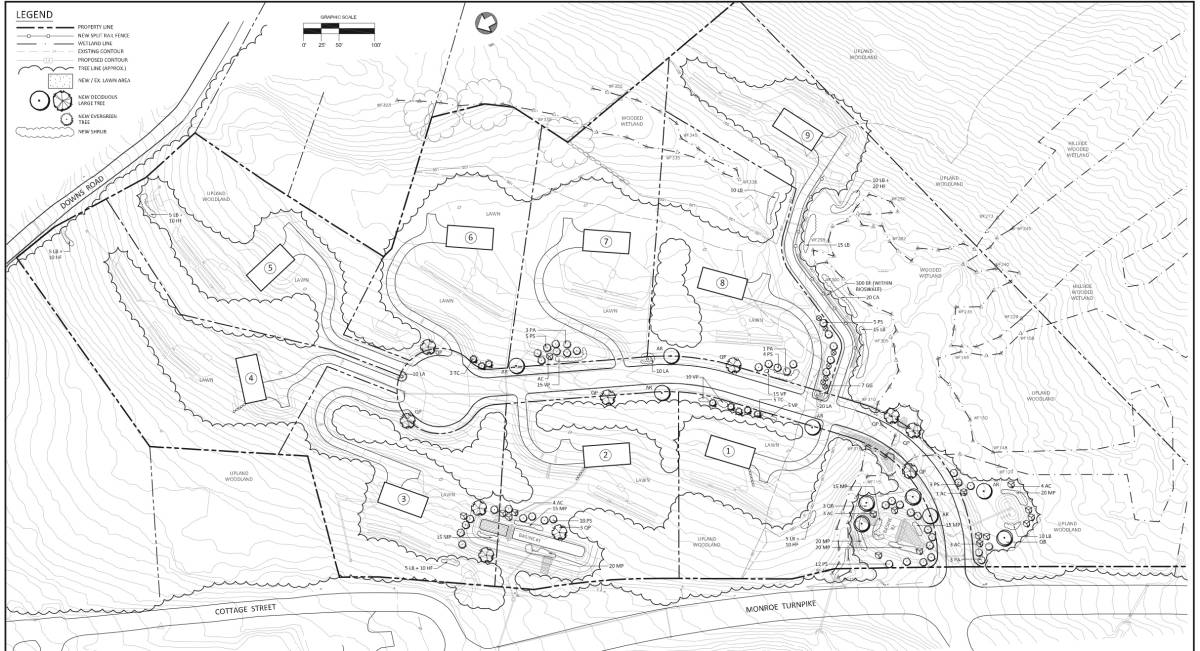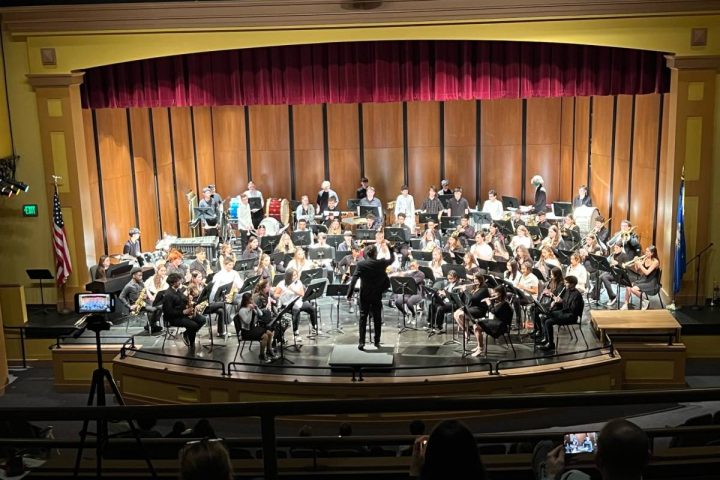MONROE, CT — A developer proposing to build Sun Valley Glen, a nine-unit cluster housing community at 1536 and 1564 Monroe Turnpike, has yet to make a formal presentation to the Inland Wetlands Commission to obtain a wetlands permit, but neighborhood opposition has already been expressed during two meetings.
Residents against the plan are expressing concerns over their wells, water quality and wildlife and insist vernal pools and other wetlands habitats exist on the property. On Feb. 26, police responded to a complaint, warning one resident who posted pictures and video of the property on Facebook, not to trespass on the private land.
The hearing, which began on Feb. 14, was continued last Wednesday. During public comments, Wade Alix, of Easton, who said his father-in-law owns the property, said commissioners, town employees, the applicant and anyone else authorized will be allowed to access the property, but anyone else who comes there will be prosecuted for trespassing.
Alix also warned people not to spread false information about the property.
For the second straight meeting, the applicant Jans Land Development LLC and its representative, J. Edwards & Associates, asked the commission to table the application to allow for more time to prepare their presentation.
The commission expects them to make their presentation on March 13, but allowed the public to speak on the plan a second time.
Once again, residents expressed strong opposition to the subdivision and disagreement with the commission over its jurisdiction, arguing that the effect on their wells and wildlife should be in its purview, beyond 150 feet from the wetlands.
Planning and Zoning Administrator Kathleen Gallagher told the commission a third-party expert was asked to walk the site to see if there are vernal pools and to provide other accurate information about the site, keeping his eye open for anything else the commission should be aware of.
She also said the applicant was asked to extend the hearing to leave time for a site walk.
Gallagher said staff does not recommend a wildlife survey, because that is used primarily for state permits. However, any neighbor can have a study done on their own property and send it to the Connecticut Department of Energy and Environmental Protection for its information.
Gallagher read a letter from Fire Marshal William “Bill” Davin into the record, in which he expressed his support for a fire pond, which is proposed as part of the application. Davin said it would be vital to the fire department’s operation due to the lack of water in the area, which is not served by public water.
Gallagher also read a letter in favor of the application from Greg Beno, of Crown View Drive, into the record, as well as several letters from residents against the housing plan.
Audrey J. Wellner, of Downs Road, spoke on the commission’s lack of interest in her request that they do a Natural Diversity Data Base review during the Feb. 14 meeting.
In her letter, she wrote, “after living here for 50+ years I do not appreciate being told by someone elected into office that they do not have to give me my 1st amendment rights and listen to my concerns and grievances about the impact of fracking underground aquifers for well drilling, cellar holes, curtain drains/and or other divergences of either above ground or underground runoff streams, ponds or wetlands that will impact my rights to clean fresh potable drinking water that was available to me when I bought my property in 1970 and over the years has been siphoned off to where I’m at the point of losing my well.”
“It is a blatant misstatement of the guidelines of your commission that the disruption of the wetlands in this area hasn’t any impact on the migratory pathways and habitat of the native and endangered species that use this property to survive on,” she added.
Mark LaMont, of Downs Road, sent photos of skunk cabbage and videos to town land use staff to show wetlands are on the property. Gallagher replied that is private property, so the public should not be walking on it and Lamont said he understood.
LaMont wrote that he and other neighbors believe it was unfair to start the hearing without the developer presenting on Feb. 14, because now the applicant has more time to prepare a response to their concerns.
He also said he believes the public should be included in any site walk.
LaMont wrote that it seems unrealistic to be told they we must only focus their comments on the wetlands, “but not address the impact its destruction would have on wildlife habitat, plant habitat, water supply and changes to the run-off patterns of the proposed development site.”
Barbara and Alex Shook wrote, “I live in the Stevenson area and will be affected by this proposed subdivision. We bought our house 30+ years ago for the bucolic atmosphere and wildlife that walk around us. Why do people think that every open space in town needs to have a house on it?”
Their letter included drawings of animals with the message: “Do not destroy my home and wonder why I wander into yours.”
Kate Johnson, of Scholz Road, wrote a letter expressing concerns that new residents may use pesticides which could impact upon well water, and that erosion and drainage could damage neighboring properties, as well as concern over the cost to the town of maintaining a roadway over wetlands, light pollution, more students in town schools, and the impact on wildlife.
“I love living in Monroe,” she wrote. “I bought my house at 29 years old in 2019, and as soon as I saw all the trees I knew I was in the right place. I am in no way against development in Monroe. I would love to see a more walkable shopping location that could bring in people from neighboring towns to give the economy a boost, but it seems that we don’t have a town planner anymore to address that.”
“Understanding this push for mass development when there are so many other things that we could improve on has been a struggle for many residents, which is affected in the opinions stated on the Monroe Residents Facebook Page,” Johnson wrote.
Her letter included photos of area wildlife.
Paula Jelly, of Cottage Street, wrote a letter expressing concerns over deforestation on erosion and water replenishment. She said she already has problems with water runoff onto her property.
Jelly said a wildlife assessment was done on November 20, 2023, adding she believes it was bad timing with plants having died and animals hibernating for the winter.
Among the animals Jelly said she has seen or heard in the neighborhood include a Peregrine falcon, which is on the Connecticut threatened species list, sharp-shinned hawks, which are an endangered species, and Eastern box turtles, a species of concern.
Jelly said she does not agree with the environmental assessment that there are no vernal pools and asked that the developer do a Request for Natural Diversity Data Base Environmental Review.
“1564 Monroe Turnpike was purchased in 1978, 14.42 acres with some wetlands, not enough land to build 9 homes in an RF-2 zone (minimum lot size 2 acres),” Jelly wrote, “and 1536 Monroe Turnpike was purchased in 2003, 19.68 acres, that is mostly wetlands. I hypothesize that 1536 was purchased to ‘game the system’ of minimum lot size of 2 acres.”
The hearing
During Wednesday’s hearing, Jelly asked where the fire pond would be located and if it could be also be used to provide fire protection for other homes on street. Commissioners said those questions could be answered when the applicant makes a presentation.
Jelly also wanted to know if the portions of 1564 Monroe Turnpike near her property, that would be left undeveloped, could be sold and built upon later.
If a site walk is scheduled and it is not open to the public, Kelley Hangos-Carrano, of Scholz Road, asked if there could be video. She also said the town’s website says Inland Wetlands’ purview is including, but not limited to, 150 feet.
Hangos-Carrano expressed concern over the potential impact on well water for her and her neighbors. “Water is a finite thing,” she said, adding there are times when they cannot do their laundry. “Everyone will be affected.”
She said she understands the need for a fire pond. “I want thought put into that, because this will affect our quality of lives,” she said.
Kate Johnson, of Scholz Road, recalled a comment made at last meeting that the wetlands commission has no jurisdiction on wells and wildlife.
Johnson said that technically is not true, because the impact on the wetlands is linked to the levels of the water table, which affects wells and wildlife.
“The third party professional will do his review,” Chairman Keith Romano said. “They’re gonna help keep us on our target. None of the valid concerns are going to be missed here.”
“On behalf of the whole commission, we appreciate the public’s interest and concern on this application,” Commissioner Ryan Kelly said. “We want your voices to be a part of the conversation.”
All respectful comments with the commenter’s first and last name are welcome.







The Monroe Sun has used an inaccurate drawing of the project at 1536 and 1564 Monroe Turnpike, since it only shows eight lots. I suggest they use page 26 of the application which shows nine lots and a road crossing a wetland. Per Connecticut state law, you cannot build a road across a wetland.
Thanks for pointing out the drawing Paula. I used it in the past and will be sure to use an updated one going forward.
I just changed the map for this story, but unfortunately it doesn’t change the link shared on social media. I’ll use this one going forward.